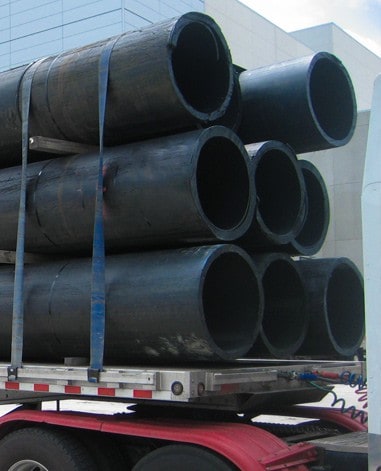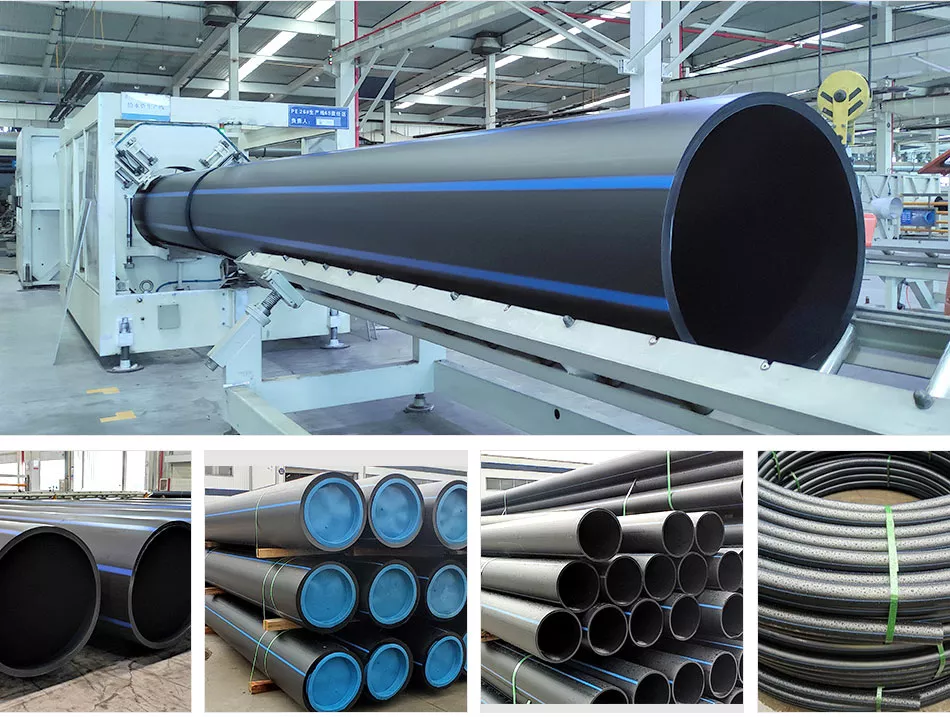Discover the Production Refine Behind High-Quality HDPE Pipeline and Its Applications
The production procedure of premium HDPE pipelines is elaborate and systematic. It starts with the selection of resources that boost efficiency. Following this, ethylene undergoes polymerization to develop material, which is after that formed with extrusion. Quality control is paramount, making certain that the end product fulfills rigorous criteria. The trip of HDPE pipes does not finish with production. Their applications throughout various sectors reveal a more comprehensive importance worth analyzing.
Understanding HDPE: Characteristics and Advantages

High-density polyethylene (HDPE) is a flexible thermoplastic recognized for its longevity and resistance to various ecological variables. This product exhibits outstanding tensile stamina, making it suitable for requiring applications. Its low-density framework adds to a lightweight product, facilitating ease of dealing with and installment. HDPE likewise showcases amazing resistance to chemicals, which reduces deterioration when subjected to extreme substances.
The product's low wetness absorption further boosts its longevity, making it perfect for use in pipes and storage space tanks. Furthermore, HDPE is immune to ultraviolet (UV) radiation, making sure that products maintain their stability also when subjected to sunlight. Furthermore, its flexibility enables the creation of intricate shapes without jeopardizing stamina. The eco-friendly nature of HDPE, often obtained from recycled materials, includes to its charm, advertising sustainable methods in production. On the whole, these buildings and advantages make HDPE a favored option for different commercial and customer applications.
Resources Option for HDPE Production
The option of raw products for HDPE production is necessary to verify the last item meets the desired specs and top quality criteria. High-density polyethylene (HDPE) is mainly produced from polymerized ethylene, acquired from nonrenewable fuel sources such as gas or petroleum. The top quality of these feedstocks significantly affects the mechanical and thermal residential or commercial properties of the final HDPE.
Additives likewise play a substantial function in enhancing HDPE's performance, including anti-oxidants, UV stabilizers, and colorants, which improve durability and resistance to ecological aspects. The option process must consider not just the chemical structure of the raw materials however also their handling characteristics to ensure reliable production.
The sourcing of raw products must prioritize sustainability and compliance with environmental guidelines, as responsible practices are important in today's market. Ultimately, careful basic material selection lays the structure for creating top notch HDPE pipelines suitable for varied applications.
The Extrusion Refine: Forming HDPE Pipeline
The extrusion procedure plays an important function in forming HDPE pipelines, beginning with meticulous material preparation methods that guarantee excellent circulation and consistency. Similarly crucial is the layout of the die, which directly influences the final measurements and surface area quality of the pipeline. Together, these variables contribute considerably to the efficiency and high quality of HDPE pipe manufacturing.
Material Prep Work Strategies
Reliable manufacturing of HDPE pipes begins with precise product preparation strategies, particularly the extrusion process. During this phase, high-density polyethylene resin is first dried to eliminate moisture, making certain suitable circulation features. The resin is then fed right into the extruder, where it undertakes home heating and melting, changing into a thick state. This home heating procedure is meticulously managed to keep the material's integrity and efficiency. The molten HDPE is required through a die, forming it into a continuous pipeline kind. Correct temperature level management during extrusion is necessary, as it straight affects the product's buildings and the final product quality. When formed, the HDPE pipeline is cooled and cut to defined lengths, ready for subsequent handling and applications.
Die Style Importance
Accuracy in die design plays a crucial role in the extrusion process of HDPE pipelines. The die offers as the final shaping device, directly affecting the pipe's dimensions, wall surface thickness, and surface coating. A properly designed die assurances consistent material flow, minimizing defects such as irregularities and weak areas. The geometry of the die need to be enhanced to suit the certain residential or commercial properties of HDPE, including its viscosity and thermal behavior during extrusion. Furthermore, the cooling rate of the product as it passes via the die can substantially impact the pipeline's structural honesty. Consequently, purchasing innovative die modern technology is crucial for suppliers aiming to create top notch HDPE pipes that meet sector criteria and customer assumptions.
Top Quality Control Actions in HDPE Production
Although various aspects affect the quality of HDPE pipe manufacturing, effective high quality control actions are important to assure uniformity and reliability in the end product. Secret quality assurance practices consist of rigorous material inspection, confirming that the raw polyethylene satisfies well established standards for purity and thickness. During the extrusion procedure, specifications such as temperature level, stress, and cooling time are closely monitored to preserve dimensional accuracy and structural honesty
Furthermore, post-production screening is important; suppliers commonly carry out hydrostatic examinations to analyze the pipeline's strength and resistance to pressure. Aesthetic examinations for surface area flaws even more enhance top quality assurance. Accreditation from relevant requirements organizations, like ASTM or ISO, supplies an additional layer of reliability. By applying these comprehensive quality assurance measures, suppliers can reduce problems, improve performance, and make sure that the HDPE pipelines satisfy the certain demands of numerous applications, eventually resulting in client contentment and rely on the item.
Applications of HDPE Pipe Throughout Industries
HDPE pipes are made use of throughout various sectors as a result of their toughness and adaptability. In water circulation systems, they ensure effective distribution, while in wastewater administration, they give reputable options for waste transport. Additionally, farming watering networks profit from HDPE's resistance to deterioration and flexibility, making it an excellent selection for modern-day farming methods.

Water Distribution Systems
A considerable variety of markets count on high-density polyethylene (HDPE) pipes for efficient water circulation systems. Understood for their durability and resistance to rust, HDPE pipelines are commonly made use of in community supply of water networks, agricultural irrigation, and industrial applications. Their lightweight nature promotes very easy handling and setup, reducing labor costs and time. Furthermore, HDPE pipes can accommodate different pressure levels, making them appropriate for both low and high-pressure systems. Pipe Manufacturing Midland TX. The versatility of the material enables seamless integration right into existing facilities, decreasing the requirement for considerable excavation. HDPE's resistance to chemical seeping warranties that the water delivered continues to be risk-free and clean, making it a perfect option for preserving the quality of safe and clean water across different fields.
Wastewater Management Solutions
Reliable water circulation systems also lead the means for ingenious wastewater monitoring remedies, where high-density polyethylene (HDPE) pipelines play a substantial role. Renowned for their sturdiness and resistance to corrosion, HDPE pipes are perfect for transporting wastewater in different setups. Their adaptability permits simple installation in intricate atmospheres, lessening the demand for considerable excavation. Additionally, HDPE's smooth indoor surface area minimizes rubbing, improving flow prices and performance. These pipes are additionally immune to chemical leaching, making sure that contaminants do not endanger the surrounding setting. Industries, districts, and treatment facilities increasingly count on HDPE pipes for their dependability and longevity, making them a favored option for modern-day wastewater management systems. This versatility highlights the crucial relevance of HDPE pipelines throughout many applications.
Agricultural Watering Networks
Agricultural irrigation networks benefit considerably from the use of high-density polyethylene (HDPE) pipes, which provide effective and reliable water distribution to plants. HDPE pipes are light-weight, making them very easy to transport and mount, while their flexibility permits different configurations in diverse terrains. These pipelines demonstrate outstanding resistance to rust, chemicals, and UV radiation, ensuring durability in rough agricultural settings. Additionally, their website smooth interior surface area reduces rubbing loss, maximizing water flow and reducing energy prices associated with pumping. The longevity of HDPE pipes, commonly exceeding half a century, adds to reduce upkeep and substitute costs. Subsequently, farmers increasingly rely upon HDPE pipes to improve irrigation effectiveness and advertise sustainable farming methods, ultimately bring about enhanced plant yields and resource conservation.
Future Patterns in HDPE Pipeline Modern Technology
As the demand for sustainable and efficient framework expands, innovations in HDPE pipe innovation are positioned to change numerous industries. Emerging trends include the assimilation of clever technologies, such as sensing units and IoT capabilities, which promote real-time tracking of pipeline problems, minimizing maintenance expenses and protecting against leaks. In addition, the growth of innovative production methods, such as 3D printing, is enabling the manufacturing of facility, personalized pipeline styles that deal with particular job requirements.
The emphasis on recycling and round economy practices is driving the advancement of HDPE pipelines made from recycled materials, improving sustainability. Enhanced jointing approaches, such as electro-fusion and mechanical installations, are also improving setup effectiveness and integrity. The expanding emphasis on environmental laws is pressing producers to embrace greener production processes, ensuring that HDPE pipes not just fulfill sector requirements however also promote a more sustainable future for infrastructure development.
Frequently Asked Inquiries
Exactly How Does HDPE Contrast to Other Plastic Products?
HDPE exceeds lots of various other plastic materials concerning sturdiness, chemical resistance, and versatility. Its low density and high tensile strength make it perfect for different applications, frequently exceeding alternatives in both performance and durability.
What Are the Ecological Effects of HDPE Manufacturing?
The ecological influences of HDPE production include greenhouse gas exhausts, power intake, and prospective air pollution from manufacturing procedures. Furthermore, improper disposal can lead to dirt and water contamination, elevating worries about lasting eco-friendly results.
Can HDPE Pipeline Be Recycled?
Yes, HDPE pipelines can be recycled. Several facilities accept made use of HDPE for handling, changing it right into brand-new products. This recycling adds to sustainability initiatives, minimizing plastic waste while conserving resources and power in the production cycle.
What Is the Life Expectancy of HDPE Piping?

Exactly How Do Temperature Variants Affect HDPE Pipeline Performance?
Temperature variations significantly influence HDPE pipe performance, impacting adaptability and toughness. High temperatures can bring about softening, while low temperature levels may create brittleness, ultimately affecting the pipe's sturdiness and suitability for various applications in varied atmospheres.